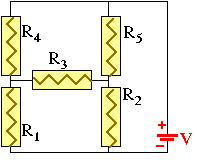Kirchhoff Rules
 There
are circuits, such as the one on the right, that cannot be reduced to
an equivalent series or parallel
resistance. What to do? Fortunately, there are two rules, named after
Kirchhoff, that enable us to solve all circuits containing any
arbitrary arrangement of resistors and batteries (or, more generally,
sources of external potential differences). Kirchhoff's rules, in the
form they are stated here, do not apply to circuits containing
"active components" (e.g. transistors that amplify), or "non Ohmic"
components -- they work only with so called "linear", (or "passive")
components.
There
are circuits, such as the one on the right, that cannot be reduced to
an equivalent series or parallel
resistance. What to do? Fortunately, there are two rules, named after
Kirchhoff, that enable us to solve all circuits containing any
arbitrary arrangement of resistors and batteries (or, more generally,
sources of external potential differences). Kirchhoff's rules, in the
form they are stated here, do not apply to circuits containing
"active components" (e.g. transistors that amplify), or "non Ohmic"
components -- they work only with so called "linear", (or "passive")
components.
Rule 1:
The net current flowing into any junction must equal to
the net current flowing out of that junction.
 Ii = 0
Ii = 0
This tells us that the sum of all currents Ii, i = 1,
..., n, at any given junction is 0, where we count currents flowing
into a point as positive, and currents flowing out of the point as
negative. Basically, this tells us that "what goes in must come out"
-- that's just the principle of conservation
of charge.
Rule 2:
The sum over all potential differences around any closed
loop must sum to zero.
 Vk -
Vk -  Ii Ri = 0
Ii Ri = 0
where the individual Vk, k = 1, ..., m, are the
potentials supplied by the batteries in a given loop; and
Ii, i = 1, ..., n are the currents flowing through the
resistors Ri, resulting in voltage drops across the
resistors in that same loop.
If you multiply both of these quantities with the current flowing
in the respective arms of the loop, you realize that the first is the
power generated in the batteries or other
sources of external potential difference, and the second is just the
power dissipated. So this rule is basically a
statement of the principle of conservation
of energy.
How can one use Kirchhoff rules?
- In a complicated circuit, like the one above, you list which
quantities are unknown (usually the currents flowing through
different wires, or potential between two points).
- Now you need to use Kirchhoff rules to find as many equations
as there are unknowns.
- Once you have a system of N equation for your N unknowns, then
you can solve it with standard linear algebra. (You may not know
what the phrase "standard linear algebra" means, but we will
discuss some examples in detail, and you will recognize the
general procedure.)
©
MultiMedia
Physics
2000
 There
are circuits, such as the one on the right, that cannot be reduced to
an equivalent series or parallel
resistance. What to do? Fortunately, there are two rules, named after
Kirchhoff, that enable us to solve all circuits containing any
arbitrary arrangement of resistors and batteries (or, more generally,
sources of external potential differences). Kirchhoff's rules, in the
form they are stated here, do not apply to circuits containing
"active components" (e.g. transistors that amplify), or "non Ohmic"
components -- they work only with so called "linear", (or "passive")
components.
There
are circuits, such as the one on the right, that cannot be reduced to
an equivalent series or parallel
resistance. What to do? Fortunately, there are two rules, named after
Kirchhoff, that enable us to solve all circuits containing any
arbitrary arrangement of resistors and batteries (or, more generally,
sources of external potential differences). Kirchhoff's rules, in the
form they are stated here, do not apply to circuits containing
"active components" (e.g. transistors that amplify), or "non Ohmic"
components -- they work only with so called "linear", (or "passive")
components.